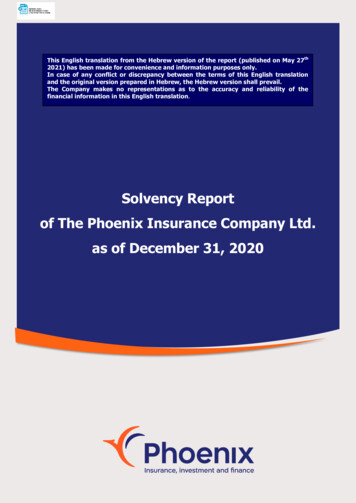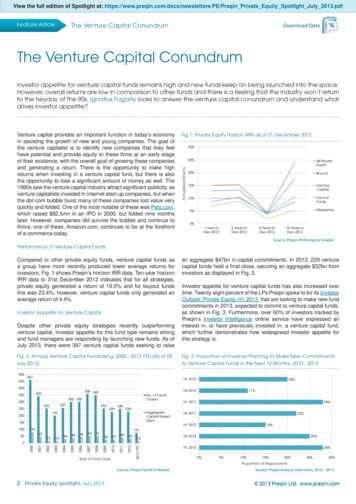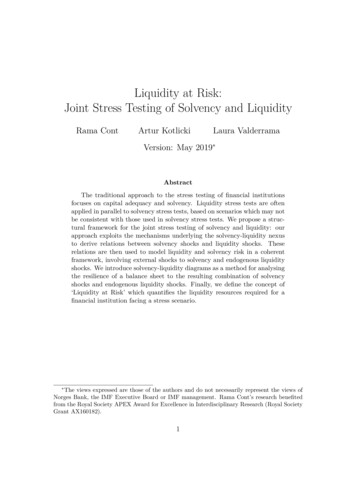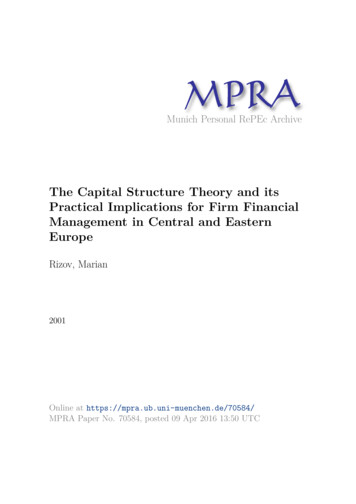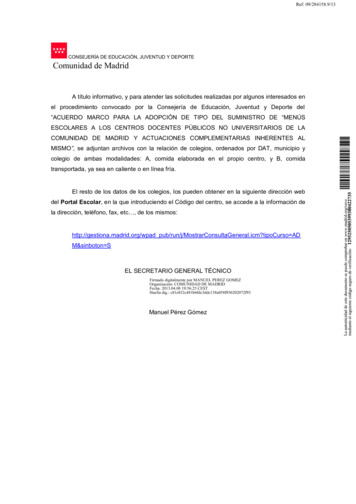
Transcription
Solvency IICapitalRequirementsand InvestmentInstrumentsA study on the impact ofSolvency II on debt marketsLast updated 09/2019For investment professional use onlyOstrum – Solvency II Capital Requirements for Debt Instruments - 1
PRELIMINARY REMARKSThis study reviews the calculation of the SolvencyCapital Requirement (SCR) and the impact ofSolvency II on debt markets.The following criteria have been used for our analysis: Standard formulaMarket risk moduleCounterparty default risk moduleThis study is not intended to be an exhaustiveanalysis of regulation. Instead, we aim to provide adetailed description of the key elements embedded inthe calculation of the SCR applied to debtinstruments.Considering the wide range of debt asset classes andthe variety of associated risks, there are multiplesituations to consider: type of coupon, indexation andembedded options (callable, puttable ), ns,infrastructure debt study with a focus on the profitability of debtinstruments under Solvency II.We acknowledge that the SCR standard formula iscomplex, and it can be considered unclear orambiguous on some very specific aspects of debtmarkets. We recommend that insurers consider thisstudy as a summary of SCR calculations, reflectingour views and our interpretation of specific points andissues relative to Fixed Income instruments.In the first section, we provide a “big picture” of theSCR standard formula. We then focus on thespecificities of the SCR for debt instruments, withspecific attention to the use of ratings and pricingmodels. The third section is dedicated to howprofitability can be measured when considering theSCR.The current version has been updated to the best ofour knowledge on August 2019. We assume that credit risk stemming from debtinstruments has no natural mitigant in the liabilities ofan insurer outside of specific cases. As a result, thedecision to invest in credit risk versus pure rateinstruments (i.e. certain sovereign debts) is typicallydriven by an objective to find a balance betweenreturn, risk and the SCR. We address this issue in ourQuick links:o Table of content belowo Acronyms and Definitions page 37.o Index page 38.o For all the detailed reference about inforce regulations see: Reference page38.Ostrum – Solvency II Capital Requirements for Debt Instruments - 2
10.2.11.OVERVIEW OF THE STANDARD FORMULASCR FOR DEBT INSTRUMENTSOVERVIEWINTEREST RATE SUB-MODULESPREAD RISK SUB-MODULE: GENERALSPREAD RISK SUB-MODULE: BONDS AND LOANSSPREAD RISK SUB-MODULE: INFRASTRUCTURE DEBTSPREAD RISK SUB-MODULE: SECURITISATIONSSPREAD RISK SUB-MODULE: DERIVATIVESMARKET RISK CONCENTRATIONS SUB-MODULECURRENCY RISK SUB-MODULEEQUITY RISK SUB-MODULECOUNTERPARTY DEFAULT RISK MODULE46781012161718192122243.PROFITABILITY UNDER SOLVENCY CAPITALREQUIREMENTRISK ADJUSTED RETURN ON CAPITALEXAMPLES ON BOND .7.CONCLUSIONAPPENDIXRELATIVE UPWARD AND DOWNWARD SHOCKSINDICES AND WEIGHTS FOR THE CONSTRUCTION OF THESYMMETRIC ADJUSTMENTSECURITISATION ISSUED BEFORE 1/1/19TABLE OF ILLUSTRATIONSACRONYMS AND DEFINITIONSINDEXREFERENCE293132323335363738Ostrum – Solvency II Capital Requirements for Debt Instruments - 3
1. OVERVIEW OF THESTANDARDFORMULAOstrum – Solvency II Capital Requirements for Debt Instruments - 4
The SCR calculation is split into severalmodules. In this study, we focus on twomodules: Market Risk Module andCounterparty Default Risk Module.We set out below the principles underlyingthe SCR calculation. The standardformula is scenario based and split intomodules. The sub-modules are thenaggregated using fixed correlations. Thecalculation of the Market Risk Modulefollows the same philosophy. It is also splitinto sub-modules, aggregated using fixedcorrelations.One of the key points in the calculation ofthe SCR is the generalized use of a lookthrough approach. Financial instrumentsheld by a mutual fund are considered tobe held directly by the insurer invested inthe fund, pro rata its investment. The same methodapplies to the financial instruments of mutual fundsheld by another mutual fund, etc.The Market Risk Module is split into the followingsub-modules: interest rate risk SCRIR,equity risk: SCREQ,property risk: SCRPR,spread risk: SCRSPREAD,market risk concentrations: SCRCONC,currency risk: SCRFX.This study focuses on debt instruments; however,we briefly consider the equity risk sub-module.Nevertheless, this sub-module has a direct impacton fixed income instruments if the insurer invests inconvertible bonds, which are truly hybrid products(mixing equity, spread and interest rate risks in acomplex way).The property risk sub-module is the slightest:SCRPR is given by a loss given by an “instantaneousdecrease of 25% in the value of immovableproperty” (Article 174). Not directly relevant for debtinstruments, it can have a slight influence throughreal estate collateral.An important point is that there is no sub-module forvolatility risk. This means that hedging strategieswith out-of-the-money options can presentinteresting opportunities from an SCR perspective.Figure 1: Standard Formula, source: EIOPAThis remark applies to rate options (swaptions, capsand floors) as well as options on credit indices or onFX rates. Accordingly, there is no volatility cost forconvertible bonds, which as a result provide cheapequity options when out of the money.The Counterparty Default Risk Module applies to: Over-The-Counter (OTC) derivatives usedfor risk mitigation and contracts with SpecialPurpose Vehicles (SPV). These areincluded in the category “Type 1exposures”;Credit exposures not caught by the spreadrisk sub-module (or the Type 1 categoryabove): These are included in the category“Type 2 exposures”. These exposures areoutside the scope of this note.The main reference documents for calculation of theSolvency Capital Requirement modules are: Directive2009/138/EC,knownas“Solvency II”,and Delegated Regulation (EU) 2015/35,known as “Level 2” regulation,o without specific reference, all thearticle numbers mentioned hereafterrefer to the Delegated Regulation2015/35.see Reference p 38. for a detailed list ofmost relevant regulation.Ostrum – Solvency II Capital Requirements for Debt Instruments - 5
2. SCR FOR DEBTINSTRUMENTSOstrum – Solvency II Capital Requirements for Debt Instruments - 6
2.1. OVERVIEWThe following sub-modules apply to debt instruments: Interest rate risk sub-module (SCRIR). This is an implicit risk in all fixed income instruments. This submodule, unlike the others, can be set off against the insurer’s liabilities.Spread risk sub-module (SCRSPREAD). This is the main source of SCR for most debt instruments. It isdriven by the credit quality (or credit rating) and the sensitivity of the instrument with respect to itsspread (modified duration).Market risk concentrations sub-module (SCRCONC). This sub-module considers the default risk in aportfolio by calculating the concentration of risky issuers (measured by the credit rating).Currency risk sub-module (SCRFX). This sub-module measures the risk of debt instruments that arenot in the currency of the insurer. It is also impacted by hedging strategies for such instruments (FXforwards or futures).Equity risk sub-module (SCREQ). For debt instruments, this sub-module applies to the equity risk onconvertible bonds and transitory equity positions which result when convertible bonds are exercised.Counterparty default risk module. This module is not involved in the Market Risk Module, but it has animportant impact on OTC derivatives, used as risk mitigation techniques or held through mutual funds.This module mainly considers the default of counterparties, which is not already taken into account inthe Market risk concentrations. Its formulation is complex, since it has a combined effect with theMarket risk capital requirement of the OTC instruments. In this paper, this is the only aspect of thecounterparty default risk module that we shall describe, but it has deeper ramifications for insurers,because it also covers contracts between insurers and reinsurers.Complex structured notes, indexed on various sources of risks, will not be discussed in this paper. However,when a proper pricing model is available for such notes, it will be possible to calculate their SCR.Diversification effects are taken into account when capital requirements are aggregated by using a correlationmatrix. Assume that the capital requirements for the various sub-modules (the property sub-module) arecalculated, let �𝑀𝑅 be the following vector, where * denotes the transposition: �𝑀𝑅 (𝑆𝐶𝑅𝐼𝑅 , 𝑆𝐶𝑅𝑆𝑃𝑅𝐸𝐴𝐷 , 𝑆𝐶𝑅𝐶𝑂𝑁𝑆 , 𝑆𝐶𝑅𝐹𝑋 , 𝑆𝐶𝑅𝐸𝑄 , 𝑆𝐶𝑅𝑃𝑅 )The SCR for the market risk module is given by ��𝑘𝑒𝑡 [(𝑆𝐶𝑅𝑀𝑅 ) 𝐶 𝑆𝐶𝑅𝑀𝑅 ]12Coefficients depends on which IR shock is retained (upward or downward), they are given by article 164.3.The first figure (in red) represents the correlation to be used when the upward shock is selected. The secondfigure (in green) represents the correlation to be used when the downward shock is 1 0/ 0.500.25 0/0.5 0/0.5 SCRSPREAD 0/ 25SCREQ 0/ 0.50.7500.2510.75SCPR 0/ 0.50.500.250.751Table 1: correlation matrix C for SCRMARKET sub modules aggregationOstrum – Solvency II Capital Requirements for Debt Instruments - 7
2.2. INTEREST RATE SUB-MODULE Reference: Articles 164 to 166, 43 to 48 and EIOPA-BoS-15/035 for the curve calculationThe interest rate sub-module is based on the calculation of losses under two opposite scenarios on the interestrate curves, which are given by the present value of the assets and liabilities minus, respectively: The present value of all interest rate curves subject to an upward shock (i.e. for all currencies)The present value of all interest rate curves subject to a downward shock (i.e. for all currencies)It is important to note that these shocks concern both the assets and the liabilities of an insurer.These shocks are defined currency by currency but are applied to each curve associated with the givencurrency.The shocks are extracted from a set of instruments specified for each currency (either swaps or governmentbonds), for tenors longer than a year. They stem from an interpolation/extrapolation method (known as theSmith-Wilson method), which is described in detail in the document EIOPA-BoS-15/0351. Each month, EIOPApublishes the official curve for each currency. However, to monitor a portfolio on a daily basis, it is necessaryto be able to produce such a curve under the current market conditions.2.2.1“Standard” Risk Free Reference curveThe key components of the risk-free rate are summarised as follows: The market rates of the instruments are3.5%decreased by the Credit Risk Adjustment3.0%(CRA). We will come back to the calculation of2.5%this quantity below.2.0%Last liquid point, LLP, is a given parameter for1.5%each currency (20 years for EUR).1.0%UFR, the ultimate forward rate, is calculated in0.5%accordance with a methodology on an annual0.0%basis and is updated when UFRs are-0.5%sufficiently different from the then applicable-1.0%UFRs.050100150Convergence maturity is the maximum of (LLPRFRLLPLLP CF 40) and 60 years. Consequently, theconvergence period is the maximal of (60-LLP)Figure 2: Zero-coupon RFR curve for EUR onand 40 years. For EUR, Convergence maturity2019/07/31 (Source: EIOPA)is 60 years.The interpolation, where necessary, andextrapolation of the risk-free interest rates should be developed by applying the Smith-Wilson method.Of course, Smith-Wilson method is not the only possible method for the stripping of the interest ratecurves.The upward and downward shocks are deduced from the interpolated / extrapolated curve by applying fixedrelative value shocks, under two restrictive conditions: The upward shock is, as an absolute value, at least 1% (Article 166.2) The downward shock is 0 for negative risk-free rates (Article 167.2)The shocks deduced from the previous steps are applied to each swap curve (through its zero-coupon form,i.e. stripped form) associated with the currency.The shocks are given in the appendix Relative Upward and Downward Shocks.1More information on EIOPA website, see Other European regulations and implementing regulations appliedOstrum – Solvency II Capital Requirements for Debt Instruments - 8
Figure 2 displays the RFR curve as given by EIOPA on 31/07/2019. We have represented the LLP (20 years)and the LLP plus CF (20 40 60). The UFR is equal to 3.9%. After the LLP, the behaviour of the curve is notdriven by the corresponding market tenors.The credit risk adjustment (CRA) is defined inArticle 45, which states that it must be in therange [10bps; 35bps]. It reflects the credit riskinvolved in swap rates. Its precise calculation isavailable in EIOPA’s document BoS15/35 and istoo long to be detailed here. However, let us saythat, for the EUR, it is based on the differencebetween the 3-month Euribor rate and the rate ofthe 3-month EONIA swap.5.0%4.0%3.0%2.0%1.0%0.0%-1.0%The shocked curves, for a given currency, are050100150used to evaluate each instrument. It is interestingto note that even if the rates of the risk-free rateRFRUPDOWNcurve are extrapolated beyond the LLP, theirFigure 3: RFR curve with upward (UP) and downwardextrapolated value only comes into play through(DOWN) shocksthe shocks on the rates after this point. However,EUR curve no volatility adjustment, 2019/07/31 (Source:for the liabilities of the insurer the risk-free rateEIOPA)curve is used as the discount curve. UnderCurve shocks,conditions the insurer can use a slightly different curve if he decides to use optional volatility adjustment ormatching adjustment.The shock (upward or downward) which is retained is the shock corresponding to the largest loss.2.2.2Risk free interest rate curve adjustment to calculate the best estimate.Without entering into detailed explanations, we list here options available for insurance institutions.2.2.2.1 Volatility adjustmentReference: article 49 to 51Insurance institutions can apply a volatility adjustment to the relevant risk-free interest rate curve to be usedto calculate the best estimate of their liabilities. For each currency, the adjustment depends on the differencebetween the interest rate that it would be possible to derive from the assets included in a reference portfolio inthat currency and the rates from the relevant risk-free interest rate curve corresponding to that currency.If they chose to apply the volatility adjustment, they must fulfil some conditions and disclose it: Their Solvencyand Financial Condition Report must precise the application and quantify the effects of cancelling the volatilityadjustment.2.2.2.2 Matching adjustmentReference: article 49 to 51Insurance and reinsurance institutions may, after authorisation, apply a matching adjustment to the relevantrisk-free interest rate curve to calculate the best estimate of a portfolio. This measure is note compatible withthe use of the Volatility adjustment nor the transitional measure on interest rates.Between the qualifying criteria : “Insurance portfolios ( ) must be subject to separate asset managementarrangements from the rest of the institution and it must be possible to replicate liability flows using the interestrate products making up the asset portfolio” (source ACPR website)2.2.2.3Transitional measure“The transitional measure concerning the relevant risk-free interest rate curve enables institutions to spreadthe impact on technical provisions of the change in interest rates from a calculation based on “Solvency I”standards to one based on “Solvency II” standards over 16 years”. (source ACPR website)Ostrum – Solvency II Capital Requirements for Debt Instruments - 9
2.3. SPREAD RISK SUB-MODULE: GENERALThe spread risk sub-module concerns all assets, financial instruments and debt instruments which are directlysensitive to a credit spread. It excludes the indirect spread effect induced by counterparty risk, such as for anOTC derivative. There are three types of SCR Spread, which apply to: Bonds and loans (SCRBONDS - see Articles 176 and 180). This covers government debt and corporatebonds and loans (excluding mortgage loans which are covered by the Counterparty Default RiskModule);Securitisations (SCRSECURITISATION - see Articles 178. This covers, in particular, ABS.Credit derivatives (SCRCD - see Article 179). This covers, for example, CDS and structured productsbased on synthetic credit instruments.The total SCR for the Spread Risk Sub-Module is given bySCR SPREAD SCR BONDS SCR CD SCR SECURITISATIONAs all three quantities are only taken into account if they are positive, there can be no set off between, say, abond and a CDS where the insurer is a protection buyer. However, under certain conditions, it is possible toset off the SCR spread for a bond against the SCR for its credit derivative hedge (see Spread Risk SubModule: DerivativesBasically, the spread risk is made up of two elements: The credit quality, which is represented by a Credit Quality Step (CQS), which is equivalent to anaggregated rating class (a CQS of 0 amounts to a credit rating of AAA, of 1 to a credit rating of AAetc.). We will come back to the construction of the CQS later.The sensitivity of the instrument with respect to a shock on the credit spread:o For bonds, loans and notes, in general, the spread risk is a function of the spread duration, whichis defined for each CQS. The function depends on the nature of the instrument, whether it is agovernment bond, corporate bond, covered bond or securitisation. For each security, the SCRBond will take the form of :SCR bonds 𝑠ℎ𝑜𝑐𝑘(𝑛𝑎𝑡𝑢𝑟𝑒, 𝑠𝑝𝑟𝑒𝑎𝑑 𝑑𝑢𝑟𝑎𝑡𝑖𝑜𝑛, 𝐶𝑄𝑆) 𝑃𝑟𝑒𝑠𝑒𝑛𝑡𝑉𝑎𝑙𝑢𝑒We have set out below the functions for the different categories.o For credit derivatives, it is the variation of the present value (PV) under certain upward anddownward shocks, the size of which depend on the CQS. It is possible to set the SCR for certainderivatives off against each other (for example, long short CDS strategies). The shock which givesthe maximum loss (after setoff) will apply.At first glance, there seems to be a clear distinction between cash and synthetic debt. However, Credit LinkedNotes (CLN) require particular attention. A CLN is, generally, a note issued by a bank or an SPV. The couponsand/or the capital take the risk under a synthetic credit derivative (on one or several entities). In this case, ourinterpretation is that: An SCRbonds needs to be calculated in order to take into account spread of the issuer.An SCRcd needs to be calculated in order to take into account the underlying credit derivative.We have set out below some explanations about the CQS and the notion of spread duration.Ostrum – Solvency II Capital Requirements for Debt Instruments - 10
2.3.1Basic facts on Credit Quality Step (Articles 4 to 6)The CQS of an asset is based on the second-best rating from 3 External Credit Assessment Institutions (ECAI)(or more). The choice of ECAI cannot be changed over the life of an instrument and must be the same forsimilar debts. If only one rating from an ECAI is available, this rating should be used. If only two ratings are available,the worst rating should be used.Securitisation positions with only one ECAI are considered to be unrated.The correspondence between CQS and rating classes is as follows (samples from a few ECAIs for long AA3BBBBaaBBB4BBBaBB5BBB6CCC, CC, C, RD, DCaa, Ca, CCCC, CC, C, D, SD/D, RTable 2: CQS and rating classes correspondence (source EUR-Lex – OSTRUM)The full mapping correspondence between credit quality steps and ECAI ratings has been adopted by theEuropean commission under: Commission Implementing Regulation (EU) 2016/1800 of 11 October 2016 22.3.2Spread duration and embedded optionsThe spread duration represents the opposite of the derivative with respect to the spread of the price of thebond, divided by the (dirty) price of the bond. For a fixed rate bond, this quantity should not be materiallydifferent from the interest rate duration. If the bond has a floating rate, the spread duration is calculated bytaking the forward value of each floating rate and considering that such rates are fixed. The interest rateduration can, in this case, be very different from the spread duration. The spread duration is expressed inyears.For the purpose of the SCRBONDS calculation the spread duration is floored at 1.For callable bonds, to our knowledge there are no explicit requirements as to how to calculate the duration.Even if it is possible to calculate the duration as at the next call date, it may be important to consider underlyingBermudian options to call the bond, implicitly sold by the investor to the issuer. This is particularly importantfor bonds with no maturity date (Tier 1) or bonds with a very long maturity (hybrid corporate bonds).2See Other European regulations and implementing regulations applied for full reference.Ostrum – Solvency II Capital Requirements for Debt Instruments - 11
2.4. SPREAD RISK SUB-MODULE: BONDS AND LOANSFor the Spread Risk sub-module for bonds and loans, there is a general case – basically for corporate seniorunsecured or subordinated debt – and several exceptions (government bonds, covered bonds, ).2.4.1General case (Article 176)This case concerns corporate bonds and loans, otherthan those listed in the specific categories describedbelow in sub-sections b) to e). In particular, it covers allbank or corporate bonds and loans (public or private),regardless of the subordination of the debt.80%60%40%20%0%0510AAAABBNon Rated15202530AABBBB and belowFigure 4: SCRBONDS for corporate bondsa function of the spread duration(Source: Ostrum AM)Figure 4 displays the evolution of the SCRBONDS as afunction of the spread duration (in years) and for thevarious CQS, represented by their equivalent ratingclass. These shocks are applied to the market value ofthe bond or loan.It is important to note that the shock for non-ratedinstruments is only slightly above the BBB shock(CQS 3), but well above the BB shock (CQS 4). Inother words, the BB shock is much larger than theshock for non-rated instruments.Commission Delegated Regulation (EU) 2019/981 3added the possibility of using internal rating when ECAI ratings are not available. Internal assessment of creditquality steps of bonds and loans, requirements and internal models are described in articles 176a to 176c.2.4.2(i)Government bonds, central and development banks and local authorities (Article 180.2-3)Several bonds and loans are exempt from SCRBONDS: bonds and loans of: The European Central BankThe central government and banks of Member States,issued in their own currencyCertain multilateral development banks and internationalorganizationsThe exemption also applies to any bond or loan which is “fully,unconditionally and irrevocably guaranteed” by any of the aboveissuers.Case study 1In France, exposure to a région,département or commune isconsidered to be an exposure tothe central government.The same favourable treatment applies to certain local authorities located in the states listed above. Theentities that benefit from this exemption are listed in the document EIOPA-Bos-15/119 and published underCommission Implementing Regulation (EU) 2015/20114.34See “solvency II” references: for full reference.See Other European regulations and implementing regulations applied for full reference.Ostrum – Solvency II Capital Requirements for Debt Instruments - 12
(ii)For the bonds and loans of central banks andstates of countries which are not listed above (forinstance, US or Japanese treasuries) anddenominated in their own currency, specificshocks apply (Article 180.3). They are 0 for AAAand AA (CQS 0 and 1). The shocks for other CQSare displayed in Figure 5. We can see that,compared to corporate bonds, these shocks aremuch more favourable.60%50%40%30%20%10%0%0For example, for a BBB with a spread duration of 10, theshock is 10.5% for this type of sovereign bond and 20%for a corporate bond (see Figure 4).51015AAA - AABBBB and below202530ABBFor ratings below BBB, the shocks for the sovereignFigure 5: SCRBONDS for non-European sovereignbonds are equal to the shocks for a corporate with abonds as a function of the spread durationCQS which is one notch more favourable: BB sovereign(Source: Ostrum AM)bonds are treated as if they were BBB corporate bonds,B and below sovereign bonds are treated as if they were BB corporate bonds.All sovereign bonds with a CQS denominated in the local currency benefit from these more favourable shocks.The others (foreign currency or non-rated) are treated as corporate bonds.2.4.3Covered bonds (Article 180.1)Covered bonds, which are dealt with in Article 180.1,are defined in the European Directive UCITS IV (N 2009/65/EC). This Directive defines several conditionsfor a bond to qualify as a “covered bond”. In particular,the covered bond must be issued by a credit institutionwhich has its registered office in a Member State, inEURO, see examples below.Covered bonds which are rated CQS 0 and 1 (AAA andAA) benefit from a favourable treatment.20%15%10%5%0%Figure 6 illustrates the difference between theSCRBONDS for covered bonds (continuous lines) and theSCRBONDS for standard bonds (dotted lines), for AAAand AA rating classes.The contribution to the SCRBONDS of an AA coveredbond is equivalent to the contribution of a AAAstandard corporate bond.0510AAACorp AAA152025AACorp AA30Figure 6- SCRBONDS for AAA-AA standard andcovered bonds, as a function of the spread duration(Source: Ostrum AM)Case study 2Case study 3A bond from a French Agency (such asCADES) issued in EUR and guaranteedby the French Government does notattract an SCR spread. The same bondissued in CHF would have the sametreatment as a corporate bond (seeGovernment bonds, central anddevelopmentbanksandlocalauthorities (Article 180.2-3)).A covered bond issued by a US bank anddenominated in EUR is not eligible for thereduced shock. A covered bond issued by aUK bank and denominated in EUR maybenefit from the reduced shock, providedthat the other conditions are fulfilled.Ostrum – Solvency II Capital Requirements for Debt Instruments - 13
2.4.4 Non-rated collateralized bonds and loansReference: Article 214 (collateral eligibility), 176.5 (shock reduction) and 197 Risk Adjusted Value ofCollateral (RAVC).For bonds or loans for which no credit assessment by a nominated ECAI is available (a non-rated bond), butwhich are collateralized, it is possible to decrease the amount of SCR BONDS. In some circumstances, it is evenpossible to divide the classic SCRBONDS by half.The conditions for the collateral mechanism to be eligible are set out in Article 214 (together with Articles 209and 210), most of which are very subjective. Some of the key points are summarized below: If a credit event occurs, the insurer can liquidate or retain the collateralThe collateral has enough liquidity and a sufficient credit quality, and is stable in valueIt is guaranteed by a counterparty for which no risk factor for concentration applies (cf. 2.8)There is no “material correlation” between the credit quality of the collateral and the credit quality ofthe counterpartyIt is possible for a custodian to hold the collateral provided that certain criteria are met, as CQS minimum of 3.If the collateral is deemed eligible, the reduction of the SCRBONDS is calculated using a complicated formulagiven by article 176.5. The calculation is based on the Risk Adjusted Value of Collateral (RAVC). Dependingon the RAVC, the SCRBONDS may or may not be reduced. Let us consider the Market Value (MV) of the bondor loan and denote by “Fup” the shock corresponding to this bond or loan, without collateral, as a proportion ofMV. Accordingly, we denote by “Fup(collat)” the shock corresponding to this bond or loan, with the collateral.There are three different situations: If RAVC MV, then the shock is divided by 2, i.e. Fup(collat) 0.5 FupIf RAVC MV (1- Fup), then the shock is unchanged, Fup(collat) FupIf RAVC MV and RAVC MV (1- Fup), then we calculate a new shock by linear combinationbetween the two previous situations:𝐹 𝑢𝑝 (𝑐𝑜𝑙𝑙𝑎𝑡) 0.5 𝐹 𝑢𝑝 0.5 𝑀𝑉 𝑅𝐴𝑉𝐶𝑀𝑉In other words, we compare the value of the stressed collateral to the value of the bond or loan. If the valuedof the stressed collateral is higher than the market value of the bond or loan, the impact on the SCR spread isvery favourable.Now, let us turn to the calculation of RAVC, as defined in Article 197. The RAVC is the difference between theMarket Value of Collateral (MVC) and the Market Risk of Collateral (MRC)𝑅𝐴𝑉𝐶 𝑀𝑉𝐶 𝑀𝑅𝐶It is not clear in the Delegated Regulation whether the calculation of MRC is performed for a specificcollateralized bond or loan or at an aggregated level (all collateralized bonds and loans). Our interpretation isthat the calculation should be performed for each specific collateralized bond or loan. The MRC is thedifference between: The theoretical SCR for Market Risk for the bond/loan without any collateral. This SCR is calculatedby aggregating the various sub-modules using the correlation matrices.The theoretical SCR for Market Risk for the bond/loan with the collateralThe idea underlying this calculation is that the MRC must always be positive, because the collateral is intendedto reduce the SCR. However, when the collateral is a real asset (aircraft, real estate etc.), and the risk on thecollateral is significantly larger than the SCR for Market Risk that applies to the bond or loan, the directapplication of this formula may result in a negative MRC, and therefore, a RAVC greater than MVC.For example, let us consider the case of a floating rate
2.2. interest rate sub-module 8 2.3. spread risk sub-module: general 10 2.4. spread risk sub-module: bonds and loans 12 2.5. spread risk sub-module: infrastructure debt 16 2.6. spread risk sub-module: securitisations 17 2.7. spread risk sub-module: derivatives 18 2.8. market risk concentrations sub-module 19 2.9. currency risk sub-module 21 2.10.
